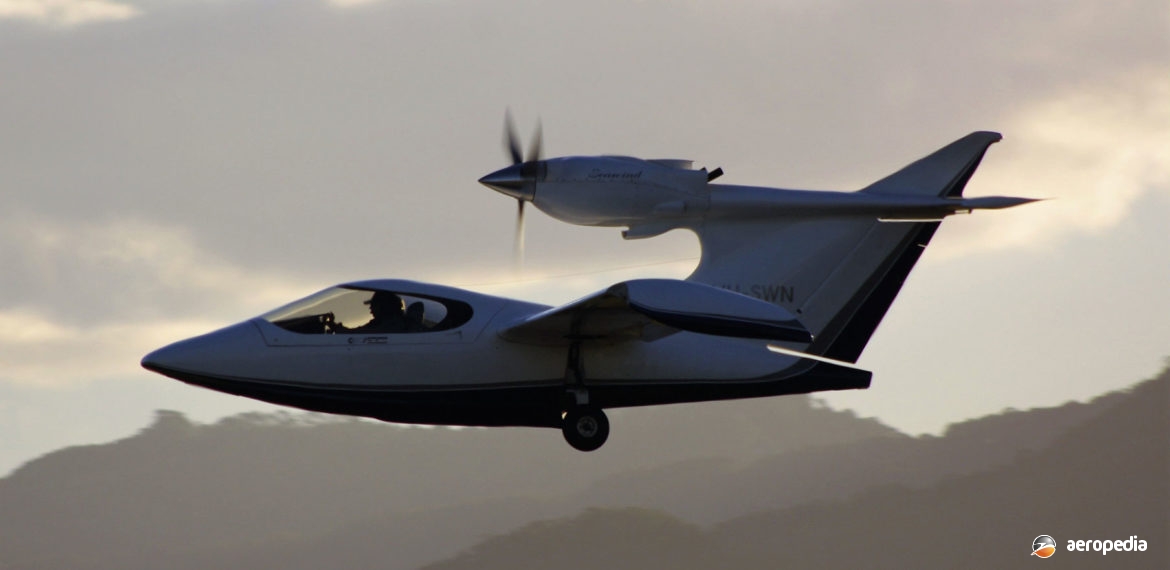Photograph:
SNA Seawind 3000 VH-SWN4 (c/n 140/038) on take-off at Albion Park, NSW in May 2013 (David C Eyre)
Country of origin:
Canada
Description:
Four-seat light amateur-built amphibian
Power Plant:
[Seawind 3000]
One 224 kw (300 hp) Textron Lycoming IO-540 six-cylinder horizontally-opposed air-cooled engine
Specifications:
- Wingspan: 10.67 m (35 ft)
- Length: 8.23 m (27 ft)
- Height: 3.1 m (10 ft 2 in)
- Wing area: 14.86 m² (160 sq ft)
- Max speed at sea level: 322 km/h (200 mph)
- Cruising speed at 75% power at 2,438 m (8,000 ft): 307 km/h (191 mph)
- Cruising speed at 50% power at 2,438 m (8,000 ft): 272 km/h (169 mph)
- Rate of climb: 381 m/min (1,250 ft/min)
- Stalling speed flaps and wheels down: 95 km/h (59 mph)
- Service ceiling: 6,309 m (20,000 ft)
- Max range no reserves: 1,577 km (980 miles)
- Max range with optional fuel: 2,350 km (1,460 miles)
- Empty weight: 1,043 kg (2,300 lb)
- Loaded weight: 1,524 kg (3,400 lb)
History:
One of a new breed of high performance homebuilt aircraft available to the amateur constructor in kit form, the Seawind 2500 was designed by Seawind Industries of Haliburton, Ontario, Canada, the prototype (C-GFNL) flying for the first time on 23 August 1982. The first series available was the Seawind 2000, fitted with a 149 kw (200 hp) Lycoming engine, kits being made available to amateur builders, each containing pre-moulded components supplied as complete sub-assemblies.
The airframe was built up GFRP wing-spar and PVC foam ribs covered with GFRP skins. The ailerons, flaps, wingtip floats, and single-step flying boat hull were GFRP/PVC foam construction; and the tail unit was of GFRP. The undercarriage was a hydraulically retractable tricycle type; and the total fuel capacity for the early series was 302 litres (66.4 Imp gals) in integral wing fuel cells. After some time the manufacturing rights were obtained by SNA Inc of Pennsylvania, and this Company developed the Seawind 3000 by installing the 224 kw (300 hp) Textron Lycoming IO-540K series engine. Most examples have been fitted with either a three or four-blade propeller.
A number have been built with turbo-charged variants of the IO-540K. A few Seawinds were fitted with 186 kw to 194 kw (250 to 260 hp) fuel-injected Lycoming engines but most are now fitted with the IO-540K series. At the Annual Awards presentation for the Best Aircraft at the EAA Airventure Oshkosh 2000 at Wittman Regional Airport in Wisconsin the Seawind won the Silver Lindy Reserve Grand Champion Award in the Seaplane category.
In 2003 Seawind Inc of Kimberton, Pennsylvania announced that, after fifteen years of developing the world’s most sophisticated amphibian kit, it had taken the next step, releasing the Seawind 3000C as a certified general aviation aircraft, describing it as “the ultimate go-anywhere, land-anywhere, executive express or holiday cruiser, combining competitive speeds and long range with the largest four/five- seat cabin in its class“. One (N123SE) in the United States was fitted with a 261 kw (350 hp) turbocharged Lycoming TIO-540-J2B engine which provided a ceiling of 7,315 m (24,000 ft) and a cruising speed of 354 km/h (220 mph).
A small number have been fitted with Allison 250-C-17 turboprops by Turbine Design Inc, these being stated to be bolt-on kits of engines and cowls removed from retired GAF Nomads, this engine weighing 88 kg (195 lb) compared with the 213 kg (469 lb) of the Lycoming unit. One has also been converted by the installation of a Pratt & Whtney PT6A-20 turboprop providing 410 kw (550 shp).
First of the type in this region was a Model 3000 imported for its builder at Tauranga in New Zealand in August 1990, subsequently becoming ZK-SWT (c/n AACA1093). This was the 34th kit built by the manufacturer and it made its first flight on 30 October 1999. However, this machine crashed on attempting to take-off from Two Mile Bay at Lake Taupo on 16 January 2005. The aircraft was subsequently shipped to Camden, NSW to a new owner and work commenced on restoring it to airworthiness. However, following the demise of its new owner the aircraft was removed from Camden and its present location is not known.
Further examples include a Model 3000 ZK-SWK (c/n 148) which made its first flight on 3 January 2001 and was registered to Seaworks Ltd of Wellington in January 2000. In May 2014 the aircraft was sold and flown to its new owner in Australia via Norfolk Island, being serviced for a period at Camden, NSW and becoming VH-XSW ( new c/n 50) and being based at Bankstown, NSW.
A Model 3000 VH-VIV (c/n 140 –N711AT) was imported to Queensland in 2001. Although it had the c/n 140, it was the 38th kit-built Seawind and this was the c/n allotted to it by CASA. This aircraft operated in Queensland from Archerfield aerodrome for a period and although the registration VH-SWN was allotted, this was not taken up and it became VH-VIV on 30 March 2004. On 17 November 2011 it became VH-SWN and was based for a period at Wedderburn, NSW; but in mid-2015 it had a problem whilst operating from near Patonga on the NSW central coast and was stranded on the beach for a period. It was later dismantled and placed in open storage at Camden, NSW where it remained in late 2019.
A further example of the 3000 became VH-ARB5 in September 2006 (c/n 005 – ex N888PA), this aircraft being registered on 28 September 2006 to Surges Bay Pty Ltd of Tullamarine, VIC. A kit was imported to the Northern Territory and work commenced on construction but as at Christmas 2015 the kit had not been completed and was placed on the market for sale.

